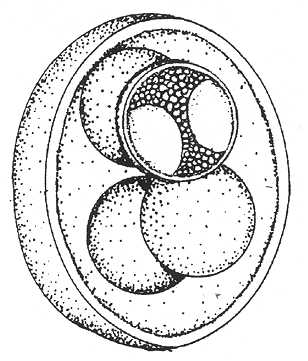Eimeria ostertagi Yakimoff and Gousseff, 1936
Type host: Erinaceus europaeus Linnaeus, 1758,
Eurasian hedgehog.
Type locality: EUROPE: Russia, Polotzk District,
Leningrad Zoo.
Geographic distribution: EUROPE: Russia.

Description of oocyst: Oocyst shape: subspheroid to ellipsod
(?);
number of walls: 1;
wall thickness: unknown, but probably < 1.0;
wall characteristics: outer layer apparently smooth;
L x W: 33.1 x 26.5 (27-41 x 22-37);
L/W ratio: 1.2
M: absent;
OR: absent;
PG: absent;
Distinctive features of oocyst: large size.
Description of sporocysts and sporozoites:
Sporocyst shape: spheroid to ellipsoid (?);
L x W: 11-12.2 x 11-12.2;
L/W ratio: 1.0 (?);
SB:absent;
SSB: absent;
PSB: absent;
SR: present;
SR characteristics: diffuse, small granules between SP or large granules that surround and
mostly obscure SP;
SP: without RB (line drawing) although this was not stated in the original description.
Distinctive features of sporocyst: variable shape, size, and distribution of SR.
Prevalence: 1 of 34 (3%).
Sporulation: Unknown.
Prepatent and patent periods: Unknown.
Site of infection: Unknown. Oocysts recovered from
feces.
Materials deposited: None.
Remarks: Yakimoff and Gousseff (1936) presented two
line drawings of E. ostertagi; one was subspheroid with spheroid sporocysts
that contained SR of large globules that obscured the SP and a second was ellipsoid
with elongate-ellipsoid sporocysts that had SR of small granules located in a compact
band between the sausage-shaped SP. It is likely they were dealing with two distinct
species, but this possibility was not stated, not were measurements given fo the
ellipsoidal sporocysts. Glebezdin and Kolodenko (1969) reported finding E. ostertagi
in a hedgehog in Turkmenia; the oocysts they measured were 26.9 x 23.9 (23-32 x
21.5-26.5) and sporocysts were 13.7 x 8.7 (8.5-14.5 x 6.5-11.5). Thus, the form
Glebezdin and Kolodenko (1969) saw is likely the unnamed form with ellipsoid
sporocysts pictured by Yakimoff and Gousseff (1936), but not E. ostertagi.
Yakimoff and Gousseff (1940) said they found this species in 2/8 (25%) Hemiechinus
albulus Stolid (?) from Kara-Kalpakia, but based their decision on the size and shape
of unsporulated oocysts only. Glebezdin (1985) also reported finding E. ostertagi in
hedgehogs (H. auritus ?) from southeastern Turkmenestan, but this seems unlikely.
References: Yakimoff and Gousseff (1936, 1940); Glebezdin and
Kolodenko (1969). 
